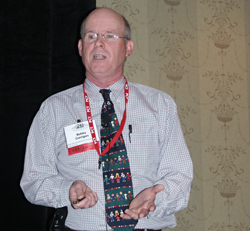It’s Man vs. Pest at the Academy, and the Winner Is ...
Purdue Alum BS '77, MS '80, PhD '95
By SEWELL CHAN
The New York Times
December 5, 2006
 |
Robert M. Corrigan |
Robert M. Corrigan is one of the nation’s foremost experts in rodent control, but it is a different species that riles him up the most.
"Are we very smart?" he asked his students last month, suggesting that a creature known as Homo sapiens, roughly translated to "wise man," should know better. "We want the rats to go away, but we keep trash under our desks. We want the city to kill the rats, but we throw McDonald’s bags out the car window."
The students are 70 city and state officials from a broad array of agencies: Sanitation, Parks and Recreation, Housing, Preservation and Development and the Metropolitan Transportation Authority. They are taking part in a three-day Rodent Control Academy, which Dr. Corrigan has taught periodically for the last year.
The classes, financed by a federal grant, are perhaps the most visible sign that the city is rethinking its strategy on controlling rats and mice. Dr. Corrigan is a leading proponent of the shift away from extermination and poisons to a new preventative approach called integrated pest management.
A balding, energetic man of 56 whose accent reflects his childhood in East Flatbush, Brooklyn, he said he had a lifelong curiosity about creatures that generally repel. "I always was interested in insects, rodents, creepy-crawlies that most people find disgusting," he said.
For several years in the 1970s, he worked for an extermination company in Manhattan, inspecting restaurants for the city and killing mice and rats for scores of private customers. His love of science led him to Purdue University, where he earned three degrees, including a doctorate in vertebrate pest management. Now he runs a consulting company in Richmond, Ind.
The academy covers everything from the role of rodents in exacerbating allergenic diseases to the proper ways to bait a rat burrow. The lessons are bolstered by dozens of handouts, a field trip and a final exam.
Rats love rotting trash, but they also feed on other creatures - insects, fish, pigeons and even other rats - as well as cat food and undigested matter in dog feces. A rat can crawl through a hole as small as half an inch, the diameter of its skull. Rats thrive in burrows, holes in walls, subway tunnels, sewers, empty lots and alleys.
Controlling them requires everything from proper use of garbage bins by restaurants to the right choice of landscaping by managers of apartment buildings. (Dr. Corrigan recommends vase-shaped shrubs rather than dense evergreens, like yew bushes, which cover hiding places on the ground.)
Dr. Corrigan loves dispelling myths like these: there is one rat per person (the number is impossible to estimate); rats grow to the size of adult cats (rats can be up to 18 inches long, from nose to tail); rats live long lives (typical lifespan: five to nine months); and poison is a panacea.
On the last point, Dr. Corrigan returns to his core message again, that humans create the habitats that allow rats to flourish. Poison alone will not work. It takes methodical, coordinated and sustained efforts to control rats.
"This is a big, long, complex problem for which there is no easy, quick solution," he said.
|